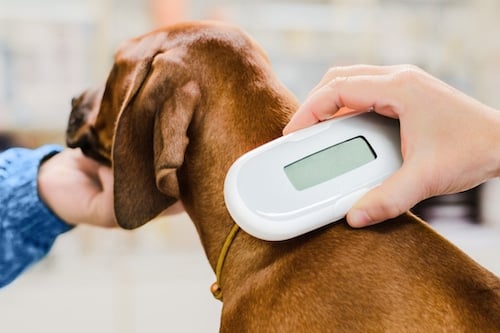- This post contains affiliate links. Read more here.
It’s every pet parent’s worst nightmare: your dog jumps the fence or slips a leash, gets loose, and takes off running before anyone is the wiser. It’s why there are so many GPS collar options available on the market. But almost all of them come with a significant price tag and a limited battery life—two issues that have driven pet parents to a new and wildly popular option for dogs: Apple’s AirTags.
Owners talk about the peace of mind, the low price point, and the convenience offered by a GPS device that doesn’t need regular recharging. But Apple doesn’t recommend AirTags for pets—and there are some compelling reasons why.
So is an AirTag for your dog a good idea? Our product testers investigate and get some answers.
Do You Need a GPS Device for Your Dog?
Lots of pet parents think that because their dog is microchipped, they’re well equipped to handle a missing pup. But that’s not strictly true, as experienced veterinarian Dr. Rebecca Greenstein points out.
A microchip is a good starting point and a valuable safety tool—after all, it’s the only device that can help if your dog has escaped without identification, collar, or tags. But it’s important to remember that it only works under a very specific set of conditions: “You’re relying on your dog being found by strangers who will present them to a clinic and have them scanned. You’re counting on your dog being found by other people. It gives you no power to find your own dog,” Dr. Greenstein says.
There’s also no universal microchip scanning system, and on rare occasions, it’s possible that scanners will fail to detect a chip.

olgagorovenko via iStock
For many, that’s a disturbing prospect. It’s why GPS devices for dogs and even cats have proliferated in recent years—to give pet parents an additional degree of control.
GPS devices use different methods to keep track of your pooch: some rely on cell service (great for urban areas but not always rural ones), radio frequency (excellent precision, but usually only within a matter of miles), Bluetooth, Google Maps, or a combination of several methods. The sea of options can be hard to navigate, and the strongest devices tend to be pricey, especially since several of the leading brands involve monthly subscriptions.
Sticker shock and confusion make Apple’s more affordable, straightforward AirTags an appealing alternative for your dog—but there are some important things to know before you buy.
AirTags are small tiles designed to be clipped to backpacks, slipped in wallets, or added to keychains to make those objects instantly discoverable on Apple’s Find My app. Just register the AirTag on the app, identify it as yours, and watch as Apple Maps shows you its exact location within a matter of feet. You can even “ping” the AirTag, causing its built-in speakers to make a sound that helps you track it down.
The feature that has pet parents really interested, though, is “Lost Mode.” If you select “Mark as Lost” from the Find My app, you’ll receive a notification any time your AirTag enters the Bluetooth range of any iPhone with cell service—any iPhone in the world. You’ll be sent the address where your AirTag was spotted, and you can even alter your settings so that the phone that came into contact with your AirTag receives a message with instructions from you.
Our favorite Italian Greyhounds Figgy and Leo (and their amazing parent Mary Vargas) demonstrate what that can look like:

For pet owners, it feels like a dream come true: not only can you get to your dog yourself, you can even personally contact the person who found your pup to ask that they hold him there for you.
The AirTag doesn’t need daily or weekly charging—its battery is typically good for about a year, and it’s user-replaceable. All you have to do is register the AirTag as yours and clip it to your dog’s collar.
And the price? One AirTag costs $29, making it easily the most affordable GPS tracking device of its kind.
So Why Doesn’t Apple Market the AirTag for Dogs?
AirTags, like everything in life, aren’t perfect—and there are some important drawbacks to be aware of if you’re considering using them for your pets.
The first thing to know is that AirTags are dependent on people with phones with service. So if you live in an unpopulated area or an area with spotty network coverage and activate “Lost Mode,” the chances are good that no one with cell service is going to pass your pup—which means you won’t get any notifications or updates about their location.

The alert you get if someone with an Apple device with service passes your lost AirTag
You’ll still have Bluetooth capabilities, so you’ll be able to see where the AirTag is within usual Bluetooth range (typically around 100 feet). You can even have it make sounds and receive directions to get to it. But unless you’re regularly losing your dog in your own house, this feature isn’t very helpful. (Mary says this did come in handy, however, when Figgy and Leo were removing their own AirTags and hiding them—clever pooches!)

The Bluetooth finding feature that lets you locate your nearby AirTag
That’s the next issue: attaching an AirTag to your dog’s collar. Because most cases and key ring loops are meant for objects instead of animals, they’re not proof against a dog’s attempts to remove them. Figgy and Leo, for example, could remove any case that clipped to their collars like a paperclip.
Test pup Oscar, a diminutive Dachshund, tried a key-ring attachment, and while he didn’t manage to remove it, he did pretty often end up dragging and banging it on the ground (no tracking device needed—you could hear him coming about a mile away).
The best way to get an AirTag on your dog is to use a case with attachment points at both the top and bottom of the tag—in short, one that requires your pup to remove their collar to get the tag off. For extra security, Mary recommends turning the tile inward so it sits against your dog’s fur instead of facing outward.
Should You Get an AirTag for Your Dog?
The Apple AirTag has some stellar qualities that rival even the best GPS trackers for dogs on the market—and at a far lower price point. But it also has critical weaknesses that may make it unsuitable for some pet parents.
What we like:
- “Lost Mode,” which sends you an alert any time an iPhone user with service passes in range of your dog
- The ability to display your contact info and instructions to anyone with an NFC-capable smartphone who taps your AirTag
- Bluetooth for proximity tracking within roughly 100 feet (we haven’t yet lost our dogs in the house, but we can’t say the same for our cats…)
- User-replaceable CR2032 coin cell battery that can power an AirTag for a year and will notify you when it’s time to replace
- Built-in speaker that enables you to “ping” your AirTag
- Small, lightweight tile (1.26 inches in diameter and 11 grams) that’s water resistant
- Personalization options, so you know which tag goes with which dog
- Low price point at $29 for a single AirTag; no monthly subscription required
What we don’t like:
- “Lost Mode” is dependent on passersby—which means it won’t be able to help you track your dog in unpopulated areas
- If your area has poor network coverage, you’re unlikely to be able to find a missing pup
- Not all AirTag attachments are suitable for dog collars, which means buyers should exercise caution
- There’s no option for a notification when your dog leaves home, a feature offered by several leading GPS devices
- AirTags don’t track your dog’s health, as leading brands can
Conclusion: It depends on where you live, what kind of dog you have, and how much you want to pay.
For those who live in remote areas or near large tracts of wilderness, the Apple AirTag isn’t a good fit for dogs; you don’t want to rely on passersby to find your missing friend. You might try a satellite GPS tracker like the SportDog TEK Series Dog Collar or the Garmin T5 GPS Dog Collar. They’re not as sleek as an AirTag, but they’re also not reliant on a dense population with cellphones at the ready.
The same goes for pet parents living with true escape artists—the dogs you just know are going to make bolting off their life’s passion—or those excited for an option with all the bells and whistles, like the Whistle Go Explore GPS Tracker (no pun intended). To see what options might be right for you, check out our comprehensive review of GPS devices for dogs.
For city dwellers and those who aren’t ready for or interested in a higher price point, the AirTag can be a strong security measure. As Mary says, it’s a good middle-ground option between a microchip alone and a traditional GPS device—it offers a degree of peace of mind at a price point that’s hard to beat.












